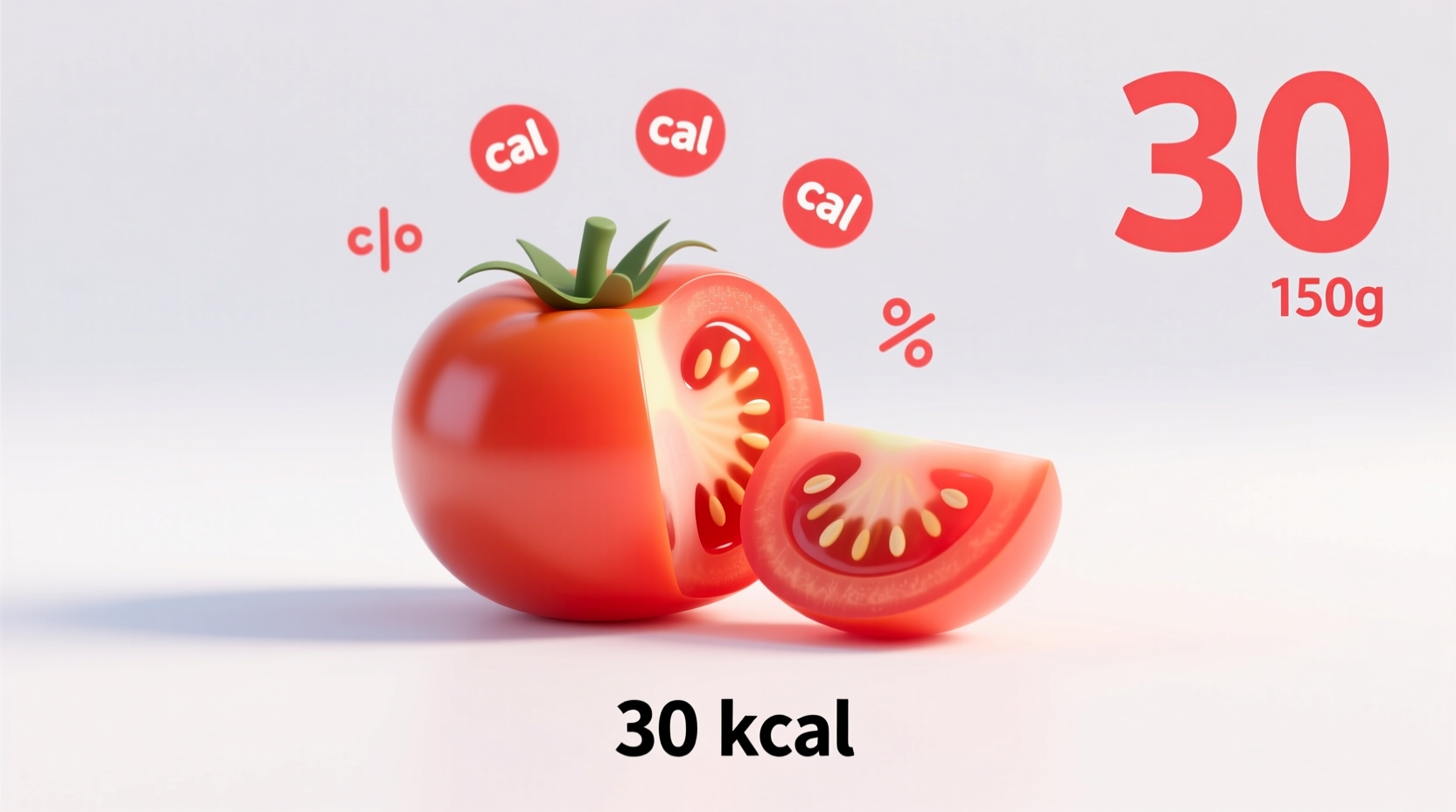A medium tomato (approximately 123 grams or 5 ounces) contains just 22 calories, making it an excellent low-calorie addition to any diet. This vibrant fruit provides 27% of your daily vitamin C needs, 10% of vitamin K, and valuable lycopene antioxidants—all while being 95% water and virtually fat-free.
Understanding exactly what you're consuming matters when you're tracking nutrition. Whether you're meal prepping, managing weight, or simply curious about healthy eating, knowing the precise nutritional profile of everyday foods like tomatoes helps you make informed dietary choices. Let's explore exactly what makes this common kitchen staple such a nutritional powerhouse.
What Exactly Qualifies as a Medium Tomato?
Before we dive into nutritional details, it's crucial to understand what "medium" means in practical terms. Many people overestimate or underestimate portion sizes, which can throw off calorie counting.
| Tomato Size | Weight (grams) | Calories | Diameter |
|---|---|---|---|
| Small | 90-100g | 17-19 | 2-2.5 inches |
| Medium | 120-130g | 22 | 2.5-3 inches |
| Large | 180-200g | 33-37 | 3-3.5 inches |
| Roma | 100-120g | 20-24 | 3 inches long |
This standardized sizing comes from the USDA's National Nutrient Database, which nutrition professionals and dietitians rely on for accurate food measurements. When recipes call for "one medium tomato," they're referring to this 123g standard that delivers precisely 22 calories.

Why Tomato Size Matters for Nutrition Tracking
Accurate portion measurement directly impacts your nutritional calculations. Consider these real-world scenarios:
- Salad preparation: A standard garden salad often contains 1-2 medium tomatoes. At 22 calories each, they add vibrant flavor without significantly impacting your calorie count.
- Meal prepping: When dividing tomatoes across multiple containers, knowing that each medium tomato equals one serving helps maintain consistent nutrition throughout your week.
- Diet tracking apps: Most apps use the USDA standard of 123g for "medium tomato," so using actual medium-sized tomatoes ensures your tracking accuracy.
Nutritional Breakdown: More Than Just Calories
While the 22-calorie count makes medium tomatoes an excellent choice for calorie-conscious eating, their nutritional value extends far beyond just being low in calories:
- Vitamin C: One medium tomato provides 27% of your daily recommended intake, supporting immune function and skin health
- Lycopene: This powerful antioxidant, responsible for tomatoes' red color, has been linked to reduced risk of heart disease and certain cancers
- Potassium: With 290mg per medium tomato, they help regulate blood pressure
- Fiber: Contains 1.5g of dietary fiber, supporting digestive health
- Hydration: Composed of 95% water, they contribute to your daily fluid intake
Research published in the American Journal of Clinical Nutrition confirms that regular tomato consumption correlates with improved cardiovascular health markers. The lycopene in tomatoes becomes more bioavailable when cooked, though raw tomatoes preserve more vitamin C.
How Tomatoes Fit Into Different Dietary Approaches
Whether you're following a specific eating plan or simply aiming for balanced nutrition, medium tomatoes offer versatile benefits:
- Weight management: Their low calorie density (few calories relative to volume) helps you feel full while consuming fewer calories
- Keto diets: With just 4.8g net carbs, medium tomatoes fit within most keto parameters when consumed in moderation
- Mediterranean diet: A cornerstone ingredient that provides flavor without added fats or sugars
- Diabetes management: Low glycemic load makes them suitable for blood sugar control
The USDA FoodData Central database consistently shows tomatoes as one of the most nutrient-dense vegetables available, delivering maximum nutrition for minimal calories.
Common Misconceptions About Tomato Nutrition
Several myths persist about tomato calories and nutrition that deserve clarification:
- "All tomatoes have the same calories": Different varieties have slightly different nutritional profiles. For example, cherry tomatoes have about 27 calories per 100g compared to 18 calories per 100g for beefsteak varieties.
- "Cooking destroys all nutritional value": While cooking reduces vitamin C content, it increases lycopene bioavailability by up to 35% according to research from NIH studies.
- "Organic tomatoes are significantly more nutritious": Research from Stanford University shows minimal nutritional differences between organic and conventionally grown tomatoes, though pesticide residue levels differ.
Practical Tips for Maximizing Tomato Nutrition
Get the most from your medium tomatoes with these evidence-based strategies:
- Pair with healthy fats: Consuming tomatoes with a small amount of olive oil (1 teaspoon) increases lycopene absorption by up to 4 times
- Store at room temperature: Refrigeration can diminish flavor and texture; keep tomatoes on your counter until fully ripe
- Use the whole tomato: The skin contains significant fiber and antioxidants—peeling reduces nutritional value
- Combine with vitamin C-rich foods: Pairing tomatoes with bell peppers or citrus enhances iron absorption from plant-based foods
Registered dietitians consistently recommend including at least 2-3 servings of tomatoes weekly for optimal health benefits. A medium tomato counts as one full serving of vegetables in most dietary guidelines.
Tomato Nutrition Through History: An Evolutionary Perspective
Understanding how our knowledge of tomato nutrition has evolved provides valuable context:
- 16th Century: When tomatoes first arrived in Europe from the Americas, they were considered ornamental and potentially poisonous, with no nutritional understanding
- Early 1900s: Scientific analysis began revealing tomato composition, though focus was primarily on carbohydrates and basic minerals
- 1980s-1990s: Research identified lycopene as a significant antioxidant, transforming tomatoes from simple vegetables to nutritional powerhouses
- Present Day: Advanced nutritional profiling shows tomatoes contain over 1,800 different phytochemicals, many with potential health benefits still being researched
This historical progression demonstrates why current nutritional data represents our most accurate understanding yet of tomato benefits.
When Tomato Nutrition Varies: Important Considerations
Several factors can cause slight variations in the nutritional content of your medium tomato:
- Seasonality: Vine-ripened summer tomatoes typically contain 20-30% more vitamin C than greenhouse-grown winter varieties
- Ripeness: Fully ripe red tomatoes have higher lycopene content than pink or orange varieties
- Preparation method: Raw tomatoes preserve vitamin C but cooked tomatoes increase lycopene availability
- Storage duration: Nutrient levels gradually decline after harvest, with vitamin C decreasing by about 15% per week at room temperature
For most practical dietary purposes, however, the standard 22-calorie count for a medium tomato remains remarkably consistent across varieties and growing conditions.











 浙公网安备
33010002000092号
浙公网安备
33010002000092号 浙B2-20120091-4
浙B2-20120091-4